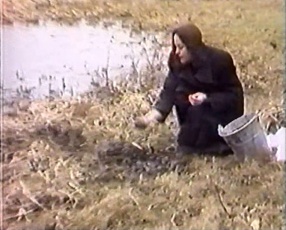TERESA MURAK (1-1/1)
In January 1989 Teresa Murak has conducted the „Bulrush” performance in Chełm. The artist took silt and grass out of the river Uherka, which were transferred to the space of the Gallery 72 at the Museum of Chełm Country. Murak has put indicative quantity of organic materials on the gallery wall and floor, which later have died out upon drying.
In 2016, Murak changed the title of the "Slime" to "Bulrush".
Slime was sourced from rivers flowing through the city where the exhibition space was located, for example in Warsaw it was taken from a small river Bach in the area of Ursynów. For the artist, the use of the slimy substance amounted to manifesting the properties of the naturaln ecosystem, where the forces of life and deatch clash in microscale: decomposition of dead plants and animals, transformation of grubs, clatsic rock production, etc. Swamp is a natural living envroment for various micro-organisms, but also a side product of great many natural processes. Teresa Murak’s activities with slime provide a liaison between actions beyond the galery or museum space and organic (therefore subject to metamorphosis) installations exhibited at art institutions. Consequently, they can be classified in Smithson’s terms as: site (real site, particular location on the map, inaccessible for the viewer – world undisturbed by humans), and non-site („artificial site”, sterile, e. g. galery or museum hall – „edited” world). The site can be represented in the non-site by means of samples of material (rock, earth, slime, etc.), as well as photographic and film documentation, notes or maps. Another importsnt term introduced by Robert Smithson, which comes in handy upon interpretating Teresa Murak’s works is dispacement, which stands for the journey from the site to the non-site, in this case of slime sourced from the river to the galery, where stands for the journey from the site to non-site, in this case of slime sourced from the river to the galery, where it was dispersed on the walls and in the corners of halls. Slime became a conveyor for primitive energy – drying and flaking, the slime paintings „pursued labour”, an ongoing imminent metamorphosis of the organic components of the work. To refer to Smithson’s linguistic metaphors, the slime on the wal lis a synecdoche that evokes the real world beyond the galery walls.
[S. Cichocki, Prace ziemne. Teresa Murak i uduchowienie szlamu, [w:] Teresa Murak. Do kogo idziesz, Galeria Labirynt, Lublin 2012.]
